Exploring Quartz Thin Sections: Insights in Geology

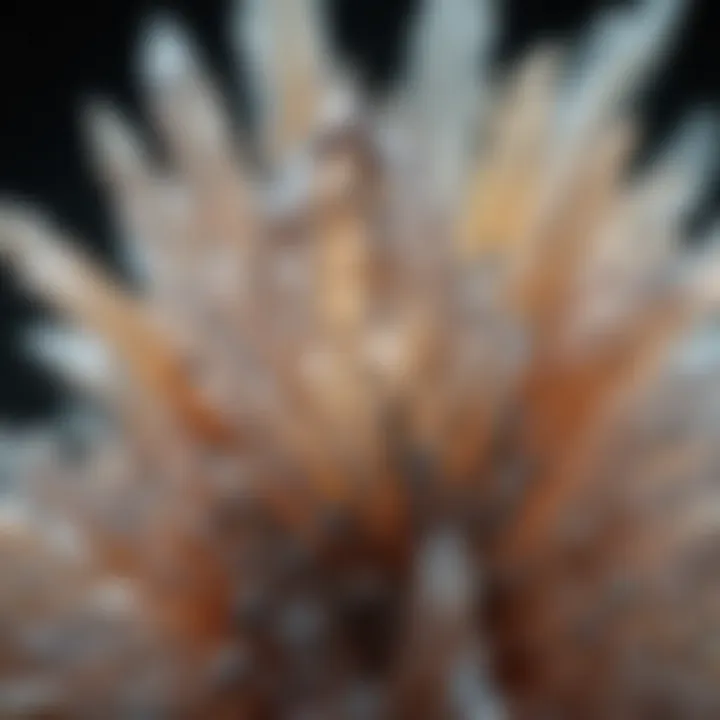
Intro
Quartz thin sections are an essential tool in the study of geology, mineralogy, and even paleontology. The microscopic view they offer unveils not just the beauty of quartz crystals but also the story of earth's history. Quartz, in its myriad forms, plays a vital role in understanding geological processes and transformations through time. The fascinating interplay between light and minerals at a microscopic scale can illuminate the evolutionary journey of our planet, making quartz thin sections a treasure trove for both researchers and collectors alike.
History and Origins
Understanding the historical background of quartz thin sections enriches the appreciation for their scientific significance. Quartz itself is one of the most abundant minerals in the Earth's crust, found in various geological settings. Its history stems back to the formation of the Earth, as it crystallized from molten rock over millions of years.
Overview of Collectibles, Rocks, and Fossils
Many rock and fossil collectors have a penchant for quartz. Its durability makes it a perfect candidate for collecting. Here are some collectible traits:
- Diverse Color Range: From clear to smoky, rose, and amethyst, quartz comes in numerous colors.
- Physical Characteristics: Known for its hardness, it ranks 7 on the Mohs scale.
- Geological Settings: Found in igneous, sedimentary, and metamorphic environments, enhancing its collectible value.
The significance of quartz extends beyond mere aesthetics. Collectors often seek out specimens for educational purposes, with quartz thin sections providing invaluable insights into geological processes.
Historical Significance and Cultural Impact
Throughout history, quartz has captivated human imagination. Cultures have revered it as a symbol of clarity and purity. The ancient Greeks believed that quartz was ice that had permanently frozen, while in many indigenous cultures, quartz crystals were used in rituals and spiritual practices. This historical layered significance underscores the need to study quartz from both scientific and cultural lenses.
Identification and Classification
Identifying and classifying quartz can be a rewarding endeavor for enthusiasts and educators alike. Recognizing different types of quartz and their unique characteristics can deepen one's understanding of the mineral and its various applications.
Guide to Identifying Rocks and Fossils
While quartz is straightforward to identify, certain nuances can often pose challenges. Here’s a handy guide:
- Visual Inspection: Check for clarity, color, and structural form.
- Finger Test: Scratch other minerals; if quartz stands firm, it’s likely a strong specimen.
- Crystal Habit: Look for common formations like hexagonal prisms or pyramid-like shapes.
- Examine Under a Microscope: This crucial step can reveal the detailed texture and inclusions which highlight the uniqueness of each thin section.
Common Types and Variations
Different varieties of quartz present unique qualities that are of interest to collectors and researchers:
- Clear Quartz: Often referred to as rock crystal, it is prized for its transparency.
- Smoky Quartz: Known for its brown to black hues, it results from natural irradiation.
- Amethyst: A violet variation that forms in geodes.
- Citrine: Characterized by its yellow or orange color, it is often heat-treated amethyst.
Each of these variations carries its implications for geological study and appreciation. When analyzing quartz thin sections under a microscope, the differences become even more pronounced, with internal features telling stories of their geological past.
"Quartz does not only represent a mineral but serves as a record of natural history engraved in its structure."
Prelims to Quartz Thin Sections
The study of quartz thin sections holds a special place in the realm of geology. They serve as windows into the microscopic world of mineralogy, granting geologists and enthusiasts alike a closer look at the intricate details that define various rock types. In this section, we will explore the essence of quartz thin sections, shedding light on their definition, providing historical context, and discussing their significance in geological studies.
Definition and Overview
Quartz thin sections are extremely thin slices of rock or mineral specimens, typically around thirty micrometers in thickness, that are mounted onto glass slides for microscopic examination. The primary aim behind creating these sections is to unveil the mineral assembly and the textural characteristics of the specimens, which remain otherwise hidden to the naked eye.
In essence, these thin sections allow geologists to observe not just the individual mineral grains, but also their relationships, habits, and alterations. The standard procedure involves cutting a sample with a diamond saw, grinding it down, and then polishing it to a fine finish. This process ensures that the unique properties of quartz are highlighted under polarized light and other analytical techniques.
Historical Context
The use of thin sections dates back to the early days of mineralogy and petrology, with pioneers like William Nicol contributing significantly to the field through the development of polarizing microscopy in the 19th century. This innovative step set the stage for meticulous geological investigations that are now standard practice.
As geology evolved, the importance of quartz thin sections became apparent, particularly in understanding sedimentary processes and metamorphic transformations. Their implications extended far beyond basic observation, birthing a new wave of insights into Earth's history and its complex systems.
Importance in Geological Studies
The significance of quartz thin sections in geological studies cannot be overstated. They facilitate:
- Detailed Petrographic Analysis: Researchers can identify mineral composition, grain size distribution, and textural relationships within the rocks.
- Tectonic Insight: By examining thin sections, geologists unravel past tectonic events, deciphering how certain rock formations were shaped over millions of years.
- Paleoclimatic Reconstructions: The data gleaned from quartz thin sections often provides clues regarding ancient environments, aiding in reconstructing past climates and geological conditions.
"Recognizing the intricate structures and history within quartz thin sections reveals a larger narrative about Earth’s evolution and the forces that have sculpted its surface."
Ultimately, those who are deeply entrenched in rock and fossil collecting can appreciate the role quartz thin sections play in enhancing our understanding of the Earth. They not only enrich geological knowledge but also serve as stepping stones for new research avenues, bridging the gap between past events and future explorations.
Understanding Quartz as a Mineral
Quartz is a mineral that draws interest not just because of its occurrence but also due to its diverse applications and intrinsic properties. It's one of the most ubiquitous minerals found on Earth, appearing in various geological settings. In this section, we will uncover the chemical composition of quartz and delve into its crystal structure and properties, showcasing why understanding quartz is fundamental in geological studies and beyond.
Chemical Composition
Quartz is primarily composed of silicon dioxide (SiO2). This simple yet robust formula masks the mineral’s complexity and utility. The silicon and oxygen atoms bond in a highly structured manner, forming a three-dimensional framework.

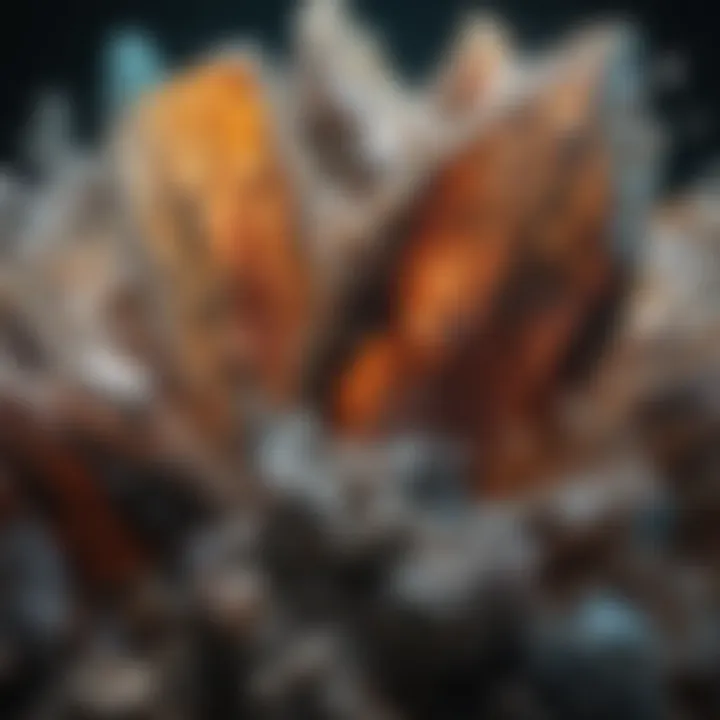
- Silicon and Oxygen Ratio: Each silicon atom is covalently bonded to four oxygen atoms in a tetrahedral shape. This geometric arrangement contributes to quartz's strength and stability.
- Variants: While SiO2 is the standard form of quartz, various impurities can alter its characteristics. For example, the inclusion of iron may lead to smoky quartz, while aluminum can create amethyst.
- Geological Importance: Recognizing these variations allows geologists to trace the history of rock formations and meteorological conditions that influenced quartz's formation.
Understanding the chemical composition of quartz is essential for interpreting not just its properties but also the environments in which these minerals formed. This knowledge is vital for the analysis of sedimentary rocks, where quartz often dominates the mineral composition.
Crystal Structure and Properties
Quartz exhibits a distinct hexagonal crystal structure. This crystalline arrangement plays a key role in how quartz interacts with light and behaves under different environmental conditions.
- Hexagonal System: The symmetry of the crystal structure gives quartz its characteristic shape and facilitates its cleavage properties.
- Piezoelectric Properties: An intriguing feature of quartz is its piezoelectric nature, where mechanical stress can generate an electric charge. This characteristic finds its application in various technologies, including watches and sensors.
- Hardness and Durability: Quartz scores a 7 on the Mohs scale of hardness, making it a tough mineral that can endure physical and environmental stress. This durability is another reason why quartz is often prevalent in sedimentary environments and is widely used in construction materials.
Given its intricate crystal structure and diverse properties, quartz is not merely a mineral but a significant geological player. Recognizing its features helps us, as not just collectors but also enthusiasts of the natural world, appreciate the vast history embedded in each thin section we study.
"Understanding quartz is crucial; it unlocks the story of Earth’s geological processes and gives insights into the ancient environments where it formed."
In summary, a solid grasp of quartz as a mineral enriches our studies of the Earth, allowing for a more comprehensive interpretation of geological data. Through this lens, quartz becomes more than just a mere specimen; it takes on a significant role in understanding the past and present of our planet.
Preparation of Quartz Thin Sections
Preparing quartz thin sections is crucial in geological studies because it allows scientists to observe and analyze the microscopic properties of this prevalent mineral. The preparation involves various meticulous steps that ultimately help in understanding the mineral's characteristics and its implications in earth sciences. This section explores the essentials involved in this process, highlighting the benefits and considerations necessary for achieving high-quality sections.
Collection of Samples
Collecting samples is the first step toward creating quartz thin sections, and it’s a task that requires both skill and foresight. The origin of the quartz can reveal a lot about the geological history of an area, making it important to select samples wisely. One must consider the environmental conditions and the location from which the quartz is extracted.
Selecting representative pieces of quartz from outcrops or drill cores can provide invaluable insights.
When collecting samples, the following should be kept in mind:
- Avoiding Contamination: Care should be taken to minimize any contamination from soil or other minerals, as this could affect the results of the thin section analysis.
- Sampling Techniques: Utilizing appropriate sampling tools such as chisels or rock hammers reduces the risk of altering the quartz's natural state.
- Documentation: Keep detailed records of where samples are acquired, including GPS coordinates if possible. This is useful for later referencing and for geological mapping.
Cutting and Grinding Techniques
Once samples are collected, the next step—cutting and grinding—is crucial for preparing them to be mounted and viewed under a microscope. The precision in this step directly influences the quality of the thin sections produced.
Cutting involves slicing the quartz samples into manageable pieces. Typically, a diamond blade saw is employed for this purpose. Understanding the desired thickness of the thin section is essential, as it often should be around 30 micrometers. This thickness allows light to pass through effectively during microscopy.
After cutting, grinding the samples down to the appropriate thickness using a lapidary machine is essential. This step must be performed with care, paying attention to:
- Uniform Thickness: Ensuring the quartz is uniformly ground to avoid any thickness variance that could impact visual clarity.
- Surface Quality: Quality of the surface post-grinding plays a major role. An uneven surface might scatter light, hindering optical analysis.
Mounting and Polishing
The final preparations of quartz thin sections involve mounting the ground quartz onto a slide and polishing it to achieve a clear and smooth surface. This step serves both practical and functional purposes, preparing the section for detailed analysis.
The mounting process includes applying a special adhesive that secures the quartz slice to a glass slide. Following this, polishing is done using fine polishing compounds, which ensures that the section is smooth enough for the light to transmit clearly.
Some considerations during this phase are:
- Quality of Adhesive: Using a high-quality adhesive is critical for durability and clarity in the thin section. An inadequate adhesive could result in the quartz detaching during analysis.
- Polishing Techniques: Different techniques can be employed based on the tools available. The goal remains the same: achieving a flawless finish without scratches or imperfections that could skew observations.
"Proper preparation of quartz thin sections is the key to unlocking their secrets, leading to significant insights in geology and mineralogy."
In summary, the preparation of quartz thin sections is an art and a science—each step requires attention to detail and a methodical approach. From correct sample collection to the final polishing, every action contributes to how effectively one can observe the characteristics of quartz under a microscope. This entire process not only enhances our understanding of geological formations but also adds to the rich tapestry of knowledge in earth sciences.
Microscopic Features in Quartz Thin Sections
Understanding the microscopic features in quartz thin sections is critical for unlocking insights into geological processes and the history encapsulated within these rocks. These features provide a detailed view of the mineral's formation, its environment, and the transformations it has undergone over time.
Grain Size and Shape
The grain size and shape of quartz are essential characteristics that geologists observe under the microscope. They can reveal a lot about the genesis of a rock, whether it was formed under high-pressure metamorphic conditions or through sedimentary processes in a calm environment. For example, coarser grains often indicate slower cooling or deposition, while finer grains suggest a more turbulent environment or rapid cooling.
- Coarse grains (more than 0.5 mm): Often indicate a slower cooling process or less energy in the environment.
- Medium-sized grains (0.25 mm to 0.5 mm): Can suggest a transitional energy level in depositional environments.
- Fine grains (less than 0.25 mm): Typically associated with rapid cooling and high energy.
Moreover, the shape of the grains—whether they are rounded, angular, or even irregular—provides valuable information about transport history. Rounded grains may have traveled a long distance from their source, undergoing erosion, while angular grains suggest they are closer to their source, experiencing less transport.
Inclusions and Impurities
Inclusions and impurities can be likened to a mineral's biography, revealing moments and conditions from its past. These elements encapsulated in quartz can range from tiny specks of minerals to fluid inclusions that hold gases or liquids. Not only do they affect the physical properties of quartz, but they can also indicate the geological conditions at the time of their formation.
- Mineral inclusions like zircon or biotite can point to the original rock source.
- Fluid inclusions provide information on the temperature and pressure conditions during quartz crystallization, crucial for understanding hydrothermal processes.
Geologists often study these inclusions to uncover the timing of mineral formation and the nature of the environments in which they exist. For example, the discovery of inclusions can suggest the quartz is part of a metamorphic process, a sedimentary rock, or even a hydrothermal deposit.
Optical Properties
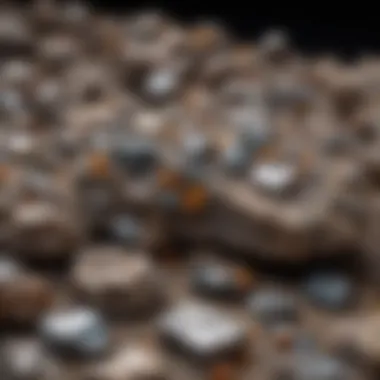
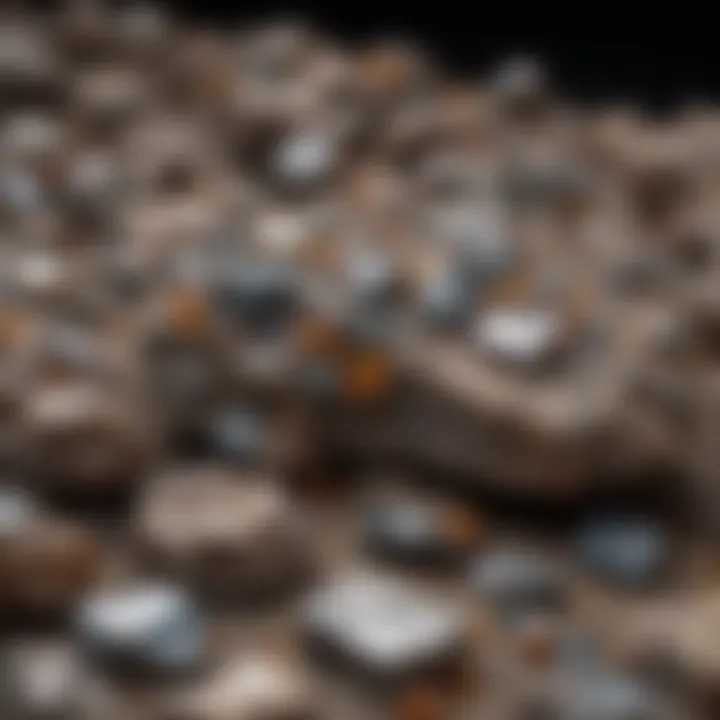
Optical properties of quartz thin sections are another area that captivates geologists. Polarized light microscopy, a common technique used, reveals thrilling details about the mineral's structure and chemical makeup. When viewed under polarized light, quartz exhibits unique qualities such as birefringence, which is the difference in refractive indices that results in color and brightness variations.
- Uniaxial vs Biaxial: Quartz is classified as uniaxial, which has implications for interpreting its formation and history.
- Color and Clarity: These properties can hint at impurities or stress conditions, which can illuminate its geological narrative.
The understanding of optical properties becomes a gateway to discerning the environmental shifts and transformations that quartz has experienced. The interplay of light with these thin sections not only makes for a beautiful visual experience but also serves as a powerful tool in revealing the history of our planet.
"The minutiae captured through quartz thin sections offer a glimpse into the Earth’s secret past—every grain telling a story, and every inclusion a chapter in geological history."
In essence, the microscopic features in quartz thin sections are a treasure trove of information, serving as essential tools for geologists and mineralogists alike.
Techniques for Analyzing Quartz Thin Sections
Analyzing quartz thin sections is like peering into the very fabric of the Earth. Understanding these techniques is crucial for anyone keen on mining insights from geological data. Each method carries its unique strengths, nuances, and requirements, making it essential for rock and fossil collectors to grasp how these tools can illuminate the intricate details of quartz.
Polarized Light Microscopy
Polarized light microscopy (PLM) stands as one of the cornerstone techniques in examining quartz thin sections. This method exploits the distinctive optical properties of minerals when exposed to polarized light. When quartz thin sections are analyzed under polarized light, their birefringence—an optical property indicating double refraction—can be observed. This is particularly useful since quartz exhibits distinct color changes and extinction patterns, allowing mineralogists to discern grain boundaries, inclusions, and even some impurities.
Benefits:
- Mineral Identification: PLM makes it easier to identify specific traits of quartz crystals that may not be visible under regular illumination.
- Grain Size Analysis: By monitoring how light passes through different quartz grains, one can infer the size and orientation, crucial for understanding geological processes.
Considerations:
- Proper calibration of the microscope is critical to avoid inaccurate interpretations.
- A certain level of expertise is required to make definitive conclusions, as interpreting optical data can be complex.
Scanning Electron Microscopy
Scanning electron microscopy (SEM) takes visualization to another level. This technique offers unprecedented resolution, allowing for a detailed examination of the surface characteristics of quartz thin sections. By scanning with a focused beam of electrons, SEM generates high-quality images of quartz crystals, revealing textures and morphological features that traditional methods might miss.
Tip: Utilizing backscattered electron imaging can help in understanding the chemical composition of inclusions within the quartz, making SEM a powerful tool in advanced mineral analysis.
Benefits:
- High Resolution: The ability to view surface features at the nanometer scale is beneficial for understanding microstructural characteristics of quartz.
- Elemental Analysis: Coupling SEM with energy-dispersive X-ray spectroscopy (EDX) allows geoscientists to gather elemental compositions of mineral samples.
Considerations:
- Preparing samples for SEM can be time-consuming and requires precision.
- The cost of SEM facilities can be a barrier for some researchers, making accessibility an issue.
X-Ray Diffraction Analysis
X-ray diffraction (XRD) analysis offers another layer of understanding when it comes to quartz thin sections. This method helps in identifying crystalline structures and discerning the mineral phases present in a sample. Quartz's sharp and distinct diffraction patterns are key for geologists, as these patterns facilitate the identification of polymorphs and can even hint at the quartz's formation conditions.
Benefits:
- Quantitative Analysis: XRD provides quantitative data regarding the percentage composition of different minerals in the sample, highlighting how much of the section is composed of quartz versus other minerals.
- Phase Identification: The technique is instrumental in recognizing various forms of quartz, distinguishing between alpha and beta quartz, and in identifying other minerals present in the thin section.
Considerations:
- Sample preparation for XRD must be done carefully to avoid contamination, as impurities can lead to misleading results.
- Interpretation of diffraction patterns may require substantial expertise, emphasizing the importance of skilled analysis.
In summary, proficiency in these techniques offers rock collectors and geologists an invaluable advantage in their explorations. Each method provides distinct insights while enhancing our overall understanding of quartz and its role in the geological narrative.
Applications of Quartz Thin Sections
Quartz thin sections play a crucial role in various geological and mineralogical endeavors. Understanding these applications amplifies our appreciation for what lies within Earth’s crust, shedding light on processes that have unfolded over eons. The significance of quartz thin sections cannot be overstated as they serve as a key resource for field studies, academic research, and educational purposes. Let’s delve deeper.
Geologic Mapping
Geologic mapping is one of the primary applications of quartz thin sections. When geologists venture into the field, they're often equipped with the knowledge gained from analyzing these sections. They provide critical insights into the composition, texture, and structural features of rocks. In effect, quartz thin sections act as a shorthand for understanding rock history and environments.
- Identification of Rock Types: Quartz thin sections reveal essential details about mineral content, making it easier to identify various rock types. This identification is the first step in constructing reliable geologic maps.
- Understanding Formation Processes: Through careful examination, geomorphologists can ascertain how different minerals crystallized over time. This understanding directly affects interpretations about the geological processes at work in different regions.
- Stratigraphic Relationships: Analyzing thin sections helps clarify stratigraphy by outlining relationships between different rock layers. Geologists can use this information to predict the location of resources or assess potential hazards.
"Quartz thin sections are like a window into the past, offering glimpses of an ancient world that shaped our very existence."
Petrographic Studies
Petrographic studies are another area where quartz thin sections shine. This meticulous examination of rocks under polarized light plays a pivotal role in understanding the history and processes that formed them. With the right tools and techniques, petrographers can identify mineral compositions and textures with unmatched precision.
- Textural Analysis: By observing grain size and shape, researchers can infer conditions of formation, such as temperature and pressure. These factors provide clues to the geological environment of the sample.
- Inclusion Studies: Inclusions within quartz can offer valuable information about the history of fluid interactions in a rock sample. This data can help reconstruct past geological events, including metamorphism and geological timelines.
- Coloration and Fracturing: Evaluating the optical properties can help geologists track changes in mineralogy due to various forces applied over time, further enriching our understanding of rock evolution.
Educational Uses

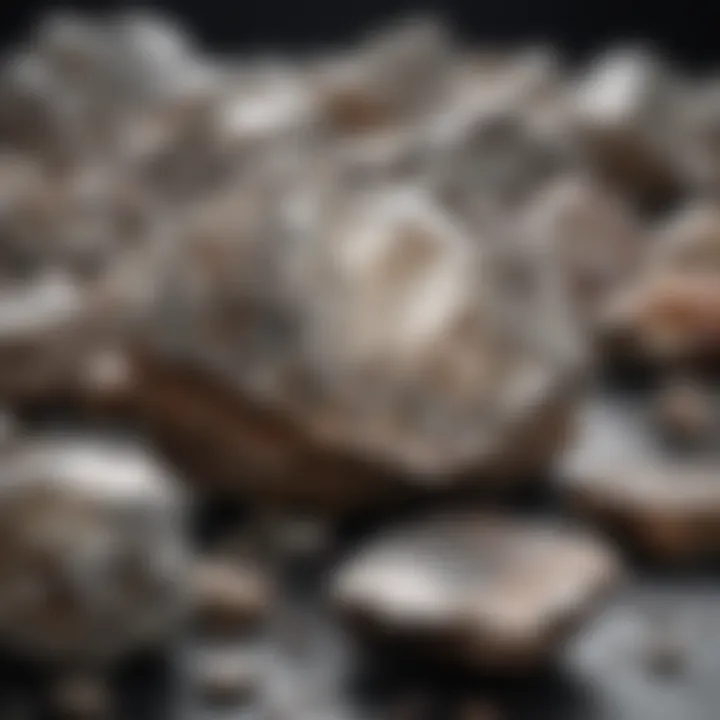
When it comes to education, quartz thin sections serve as practical tools for students and collectors alike. For aspiring geologists, these thin slices of rock become a tangible connection to theories learned in classrooms. The intricate details revealed under a microscope encourage curiosity and deeper inquiry.
- Teaching Materials: In geology classes, thin sections can provide hands-on learning experiences, bridging theory and real-world application. Students can observe firsthand how minerals behave and interact, reinforcing key concepts taught in the classroom.
- Field Studies and Excursions: Many programs utilize quartz thin sections during fieldwork to enhance understanding of geological features. This practice not only solidifies theoretical knowledge but also cultivates a sense of wonder about Earth’s complex systems.
- Collector’s Delight: For rock and fossil collectors, being acquainted with quartz thin sections opens a new dimension of appreciation. They gain insights into how these specimens were formed and can accurately identify them based on microscopic features.
In summary, the applications of quartz thin sections are vast and multifaceted, serving not only as a critical tool for professionals but also greatly enhancing educational experiences for budding geoscientists and enthusiasts. Their intricate details provide layers of understanding about our planet, compelling further exploration and appreciation of the natural world.
Challenges in Quartz Thin Section Analysis
Analyzing quartz thin sections comes with its own set of hurdles that researchers must face head-on. Every layer of quartz, every microscopic speck, and every minute detail harbors critical information. However, to access that information, one has to navigate through various challenges that can cloud interpretation and lead to missteps in geological conclusions. Understanding these challenges is crucial, not just for effective research but also for enhancing educational perspectives for rock and fossil collectors.
Sample Contamination
One of the most significant challenges in quartz thin section analysis is sample contamination. Even a seemingly innocuous dust particle can skew results. The importance of maintaining sample integrity cannot be overstated. Contaminants can range from foreign minerals to biological material, each bringing its own set of complications.
For instance, if a quartz thin section is prepared in an environment where other geological materials are handled, it's easy for minerals like feldspar or mica to unknowingly mix in. Such contamination can lead to gravely incorrect interpretations of the mineral's origin and conditions of formation.
To mitigate contamination risk, it’s essential to:
- Maintain a clean workspace during sample collection and preparation.
- Use dedicated tools for handling quartz samples.
- Regularly check and calibrate equipment, as even a small issue can introduce impurities.
Even a minor lapse in cleanliness can result in data that is more guesswork than fact.
Interpretative Difficulties
The second layer of challenges pertains to interpretative difficulties. Even when samples are uncontaminated, the inherent complexities of quartz can lead to confusion. Its diverse optical properties and variabilities in grain shapes complicate straight analysis. Techniques such as polarized light microscopy can reveal intricate details, but they also demand a trained eye to interpret correctly.
For collectors and researchers alike, it’s a fine line between seeing the obvious and recognizing the subtle signs that tell a broader geological story. Misinterpretation could occur for various reasons: misunderstanding optical effects, ties with certain mineral associations, or an incomplete geological context. To tackle these issues, researchers should:
- Approach analysis with an understanding of quartz's varied morphology.
- Pay special attention to environmental context during interpretation.
- Collaborate with experts who have experience in specific formational contexts when unsure.
"An expertly crafted thin section can feel like an endless puzzle, where every piece presents a fresh challenge to interpretation.”
In summary, while quartz thin sections hold nuggets of geological insights, the pathway to gleaning that information is riddled with potential pitfalls. Lowering the risk of contamination and refining interpretational skills requires focus and diligence, both of which are invaluable assets in the geological toolkit. These challenges not only shape the practices of seasoned geologists but also serve as fundamental lessons for the next generation of rock and fossil collectors.
Case Studies Involving Quartz Thin Sections
Exploring case studies focused on quartz thin sections is essential in understanding how these microscopic slices can illuminate significant geological narratives. They allow scientists and enthusiasts alike to piece together historical contexts, mineral compositions, and formation processes. Each study provides insights that are not always evident in broader geological assessments, offering a deep dive into the specifics of mineral interactions and environmental conditions. Moreover, engaging with these case studies aids in the development of analytical skills necessary for both academic and practical applications in geology.
Cenozoic Deposits
Cenozoic deposits are a fascinating focus for quartz thin section studies, as they encapsulate the most recent geological history of our planet. This era, often referred to as the "Age of Mammals," spans from about 66 million years ago to the present. During this time, Earth's climate and landscapes underwent significant changes, allowing geologists to observe and analyze various sedimentation processes.
In the context of quartz thin sections, Cenozoic deposits frequently reveal intricate relationships between sedimentary environments and quartz formation. Through thin section analysis, one can identify the grain size and shape variations within quartz particles, providing clues about their transport history and depositional settings. For instance, angular grains might suggest a proximal source with limited transport, while well-rounded grains typically indicate extensive weathering and transportation.
Additionally, inclusions found in quartz from Cenozoic deposits can provide vital evidence of past climatic conditions. By interpreting these features, researchers can piece together insights into historical weather patterns, sedimentary environments, and biological developments. Understanding these deposits offers a window into Earth's recent past, fostering a more comprehensive grasp of significant evolutionary milestones.
Archean Cratons
Moving further back in time, the Archean cratons present another compelling area of study for quartz thin sections. The Archean era, ranging from approximately 4.0 to 2.5 billion years ago, is characterized by the formation of the oldest portions of the Earth's crust. In these ancient geological formations, quartz represents a substantial component, often providing clues about the processes that shaped early continental crust.
Analyzing quartz thin sections from archean cratons can reveal information about the conditions under which these rocks formed. For example, the presence of specific mineral inclusions within quartz crystals might indicate the metamorphic or igneous processes that influenced their crystallization. Additionally, the textures displayed in thin sections can shed light on tectonic activities of the time, such as continental collisions or subduction.
Furthermore, the study of quartz in these ancient rocks can point to the evolution of Earth's atmosphere and hydrosphere. The chemical characteristics of quartz grains might inform scientists about early hydrothermal systems and the conditions that led to the emergence of life. By analyzing these very old deposits, we can unravel some of the mysteries associated with the planet's formative years, situating quartz as a key player in shaping terrestrial history.
"Analyzing quartz thin sections not only provides insights into the geological past but also shapes our understanding of ongoing processes that continue to impact our planet today."
Epilogue: The Significance of Quartz Thin Sections
The exploration of quartz thin sections is a cornerstone in geology and related fields. Their significance goes beyond mere aesthetic appeal; these slides are pivotal in unraveling the complex narratives woven into the Earth's crust. They offer a glimpse into the geological past, enabling researchers to decode various processes such as sedimentation, metamorphism, and diagenesis. By examining the microscopic features of quartz, geologists can gain insights into the environmental conditions that prevailed during sediment formation. This intrinsic value underscores their role in both academic research and practical applications.
But why should rock and fossil collectors care about quartz thin sections? Understanding quartz not only enhances the appreciation of specimens but also enriches the collecting experience. Knowledge of how quartz can tell stories about its formation and conditions opens avenues for collectors to consider context when acquiring new pieces for their collections.
In the grander scheme, quartz thin sections possess several advantages:
- Diagnostic Utility: They serve as diagnostic tools to identify mineral compositions and infer geological histories.
- Educational Value: In educational settings, these sections facilitate hands-on learning, allowing students to appreciate the nuances of geology at a molecular level.
- Research Applications: For researchers, quartz thin sections are essential in various fields including mineralogy, sedimentology, and paleontology.
Nevertheless, it’s important to recognize some challenges associated with quartz thin section analysis. Issues with contamination and interpretation difficulties can potentially skew results. However, with advancements in technology and methodology, these challenges are becoming easier to navigate.
"The careful study of quartz thin sections transcends mere observation; it fosters a deeper connection to the Earth’s history and processes."
Understanding quartz thin sections offers rich rewards, unraveling crucial environmental insights as we interpret the geological chronicles they represent. This narrative promises to continue evolving as new technologies and methods enhance our exploration of these complex materials.
Future Prospects and Research Directions
Looking ahead, the study of quartz thin sections is poised for exciting developments. As analytical techniques evolve, we can expect enhanced precision in identifying inclusions and features within quartz. Such advancements could lead to a more nuanced understanding of the conditions that govern mineral formation.
Several potential avenues for future research might include:
- Integration of Advanced Imaging Technologies: Utilizing cutting-edge imaging techniques, like synchrotron radiation, to offer unprecedented views of quartz's structure.
- Sustainable Sampling Methods: Research into environmentally friendly ways to procure quartz samples without damaging natural deposits.
- Interdisciplinary Studies: Collaborations that bridge geology, biology, and materials science can provide a more holistic understanding of quartz's role in various ecological systems.
These prospects not only promise to enhance the significance of quartz thin sections in academic research but also offer insights valuable to fossil collectors and geologists alike. By embracing these future directions, we can gain a clearer perspective on the geological narratives that quartz holds.



